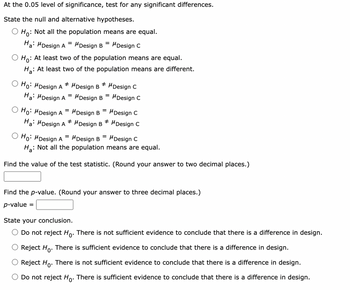
MATLAB: An Introduction with Applications
6th Edition
ISBN: 9781119256830
Author: Amos Gilat
Publisher: John Wiley & Sons Inc
expand_more
expand_more
format_list_bulleted
Question

Transcribed Image Text:At the 0.05 level of significance, test for any significant differences.
State the null and alternative hypotheses.
O Ho: Not all the population means are equal.
Ha: Design A
O Ho: MDesign A
Ho:
: At least two of the population means are equal.
Ha: At least two of the population means are different.
Ha: Design A
Ho: MDesign A
=
#
Ha: Design A
=
=
=
MDesign B Design C
#
MDesign B
MDesign B
#
=
=
MDesign B
Design B +
Design B
Design C
=
O Ho: MDesign A
Design C
Ha: Not all the population means are equal.
Find the value of the test statistic. (Round your answer to two decimal places.)
Design C
Design C
Design C
Find the p-value. (Round your answer to three decimal places.)
p-value =
State your conclusion.
Do not reject Ho. There is not sufficient evidence to conclude that there is a difference in design.
Reject Ho. There is sufficient evidence to conclude that there is a difference in design.
Reject Ho. There is not sufficient evidence to conclude that there is a difference in design.
Do not reject Ho. There is sufficient evidence to conclude that there is a difference in design.

Transcribed Image Text:In 2018, a consumer goods giant had more than 20 brands with more than $1 billion in annual sales. How does the company create so many successful consumer products? They effectively invests in
research and development to understand what consumers want. One method used to determine consumer preferences is called conjoint analysis. Conjoint analysis allows a company to ascertain the
utility that a respondent in the conjoint study places on a design of a given product. The higher the utility, the more valuable a respondent finds the design. Suppose we have conducted a conjoint study
and have the following estimated utilities (higher is preferred) for each of three different designs for a new whitening toothpaste.
Respondent
1
2
3
4
5
6
7
8
9
10
Design A
24.6
31.4
31.8
15.4
20.7
41.0
27.1
20.2
31.6
24.4
Utilities
Design B
34.4
31.4
20.2
26.4
18.3
34.0
22.5
21.8
29.4
29.0
Design C
28.8
33.9
27.8
25.1
18.2
44.8
27.3
27.9
31.3
29.3
At the 0.05 level of significance, test for any significant differences.
Expert Solution
This question has been solved!
Explore an expertly crafted, step-by-step solution for a thorough understanding of key concepts.
This is a popular solution
Trending nowThis is a popular solution!
Step by stepSolved in 2 steps with 3 images

Knowledge Booster
Similar questions
- A researcher found that counties with a high rate of passport ownership also have low rates of obesity, and counties with low rates of passport ownership have high rates of obesity. This is an example of what kind of relationship? Positive Negative Spurious Interveningarrow_forwardAccording to a Gallup poll in October 2015, having young children at home greatly influences whether women in the U.S. prefer to stay at home or work outside of it. More than half of women, 56%, who have a child younger than 18 would ideally like to stay home and care for their house and family, while 58% of those without young children would rather work outside the home. Having young children makes little difference in men's preferences, with close to three-quarters preferring to work regardless of their parenting status. Gallup states that their method has a margin of error of 0.031.(a) Give a point estimate for the proportion of all US women with a child under 18 that would like to stay at home.(b) Give an interval estimate for the proportion of all US women with a child under 18 that would like to stay at home. Use three decimal places in your answer.( , )(c) What is the difference between a point estimate and an interval estimate?arrow_forwardIn 2018, a consumer goods giant had more than 20 brands with more than $1 billion in annual sales. How does the company create so many successful consumer products? They effectively invests in research and development to understand what consumers want. One method used to determine consumer preferences is called conjoint analysis. Conjoint analysis allows a company to ascertain the utility that a respondent in the conjoint study places on a design of a given product. The higher the utility, the more valuable a respondent finds the design. Suppose we have conducted a conjoint study and have the following estimated utilities (higher is preferred) for each of three different designs for a new whitening toothpaste. Respondent Utilities Design A Design B Design C 1 24.6 34.4 28.8 2 31.4 31.4 33.9 3 31.8 20.2 27.8 4 15.4 26.4 25.1 5 20.7 18.3 18.2 6 41.0 34.0 44.8 7 27.1 22.5 27.3 8 20.2 21.8 27.9 9 31.6 29.4 31.3 10 24.4 29.0 29.3 At the 0.05 level of…arrow_forward
arrow_back_ios
arrow_forward_ios
Recommended textbooks for you
 MATLAB: An Introduction with ApplicationsStatisticsISBN:9781119256830Author:Amos GilatPublisher:John Wiley & Sons Inc
MATLAB: An Introduction with ApplicationsStatisticsISBN:9781119256830Author:Amos GilatPublisher:John Wiley & Sons Inc Probability and Statistics for Engineering and th...StatisticsISBN:9781305251809Author:Jay L. DevorePublisher:Cengage Learning
Probability and Statistics for Engineering and th...StatisticsISBN:9781305251809Author:Jay L. DevorePublisher:Cengage Learning Statistics for The Behavioral Sciences (MindTap C...StatisticsISBN:9781305504912Author:Frederick J Gravetter, Larry B. WallnauPublisher:Cengage Learning
Statistics for The Behavioral Sciences (MindTap C...StatisticsISBN:9781305504912Author:Frederick J Gravetter, Larry B. WallnauPublisher:Cengage Learning Elementary Statistics: Picturing the World (7th E...StatisticsISBN:9780134683416Author:Ron Larson, Betsy FarberPublisher:PEARSON
Elementary Statistics: Picturing the World (7th E...StatisticsISBN:9780134683416Author:Ron Larson, Betsy FarberPublisher:PEARSON The Basic Practice of StatisticsStatisticsISBN:9781319042578Author:David S. Moore, William I. Notz, Michael A. FlignerPublisher:W. H. Freeman
The Basic Practice of StatisticsStatisticsISBN:9781319042578Author:David S. Moore, William I. Notz, Michael A. FlignerPublisher:W. H. Freeman Introduction to the Practice of StatisticsStatisticsISBN:9781319013387Author:David S. Moore, George P. McCabe, Bruce A. CraigPublisher:W. H. Freeman
Introduction to the Practice of StatisticsStatisticsISBN:9781319013387Author:David S. Moore, George P. McCabe, Bruce A. CraigPublisher:W. H. Freeman

MATLAB: An Introduction with Applications
Statistics
ISBN:9781119256830
Author:Amos Gilat
Publisher:John Wiley & Sons Inc

Probability and Statistics for Engineering and th...
Statistics
ISBN:9781305251809
Author:Jay L. Devore
Publisher:Cengage Learning

Statistics for The Behavioral Sciences (MindTap C...
Statistics
ISBN:9781305504912
Author:Frederick J Gravetter, Larry B. Wallnau
Publisher:Cengage Learning

Elementary Statistics: Picturing the World (7th E...
Statistics
ISBN:9780134683416
Author:Ron Larson, Betsy Farber
Publisher:PEARSON

The Basic Practice of Statistics
Statistics
ISBN:9781319042578
Author:David S. Moore, William I. Notz, Michael A. Fligner
Publisher:W. H. Freeman

Introduction to the Practice of Statistics
Statistics
ISBN:9781319013387
Author:David S. Moore, George P. McCabe, Bruce A. Craig
Publisher:W. H. Freeman